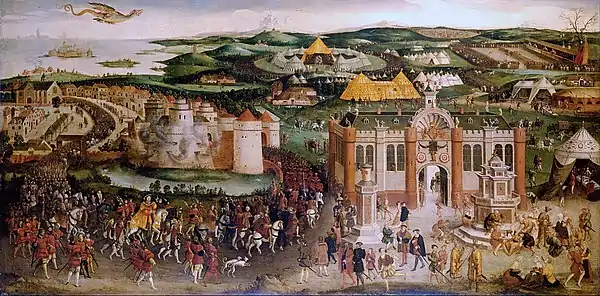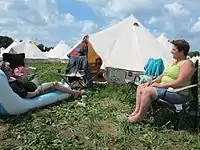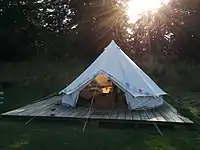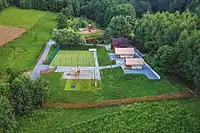Glamping
Glamping is a portmanteau of "glamorous" and "camping", and describes a style of camping with amenities and, in some cases, resort-style services not usually associated with "traditional" camping. Glamping has become particularly popular with 21st-century tourists seeking modern amenities, such as Wi-Fi,[1] alongside "the escapism and adventure recreation of camping",[2][3][4][5] in a variety of accommodations such as cabins, treehouses, and tents.[1]
History
The word "glamping" first appeared in the United Kingdom in 2005[6] and was added to the Oxford English Dictionary in 2016.[7] The word is new, but the concept that "glamping" connotes, that of luxurious tent-living (or living in other camping accommodations), is not. In the 16th century, the Scottish Earl of Atholl prepared a lavish experience in the Highlands for the visiting King James V and his mother. Here, the Duke pitched lavish tents and filled them with all the provisions of his own home palace.[8]
Probably the most extravagant example of palatial tent-living in history was the Field of the Cloth of Gold, a diplomatic summit in 1520 between Francis I of France and Henry VIII of England in northern France. Some 2,800 tents and marquees were erected, and fountains ran with red wine.[9][10]

At around the same time, the Ottomans had ostentatious, palatial tents transported from one military mission to the next. Entire teams of artisans travelled with the army to erect and maintain these imperial tents. As described by Professor Nurhan Atasoy,
The exquisite ornamentation both inside and out of the tents used by the Ottoman sultans made them imposing dwellings fit for a ruler. On ceremonial occasions tents served to create a splendid theatrical setting, as we see vividly portrayed in miniature paintings depicting banquets, audiences and celebrations which took place in the imperial tent complex over the centuries. The imperial tents were richly decorated as if they were pavilions, and often had designs resembling tiled panels, usually in floral patterns, either in appliés work using cloth of different colours, or embroidered in various stitches using silk and metal thread.[11]
Recent trends
Some 400 years later, in the 1920s, an African safari became "the thing to do" among wealthy Americans and British. But wealthy travelers, even those in search of adventure, were not willing to sacrifice comfort or luxury. From electric generators, to folding baths, and cases of champagne, travelers were afforded every domestic luxury while on adventure.[12]
Others have suggested that recent interest in glamping can be traced back to the 1990s, as safari camps became increasingly popular in Africa and coastal Thailand.[13] In 2011, CNN reported that glamping had also become popular in the United States, Europe, and Australia.[13] The modern version of glamping offers holidaymakers with "spacious designer-outfitted tents complete with soft sheets instead of sweaty sleeping bags".[13] By minimizing the impact on the environment of constantly unpacking tents and poorly discarding waste, glamping is also arguably environmentally friendly.[13]
Since 2020, the tourism industry has seen renewed interest in glamping, due to the global outbreak of the COVID-19 pandemic,[1][14] because it allows for social distancing and provides opportunities for outdoor recreation.[1]
 Glamping at the music festival Zwarte Cross in the Netherlands
Glamping at the music festival Zwarte Cross in the Netherlands A glamping hut at Norwich, United Kingdom
A glamping hut at Norwich, United Kingdom Glamping "Pod Gwiazdami", Pietrusza Wola, Poland
Glamping "Pod Gwiazdami", Pietrusza Wola, Poland
References
- Craig, Christopher A.; Karabas, Ismail (April 2021). "Glamping after the coronavirus pandemic". Tourism & Hospitality Research. 21 (2): 251–256. doi:10.1177/1467358421993864. S2CID 233186057 – via SAGE Publications.
- Lickus, Jay (11 March 2015). "Have You Ever Been 'Glamping?'". Huffington Post.
- Southerden, Louise (19 March 2015). "Six of the best: New Australian glamping camps". Sydney Morning Herald.
- Devine, Darren (17 March 2015). "Glamping's yurts, podes and domes continue to lead way for Welsh tourism". Wales Online.
- "'Glamping' brings creature comforts to outdoors". USA Today. 2011-08-04. Archived from the original on 2013-12-06. Retrieved 2011-09-27.
- Harpaz, Beth (4 September 2014). "Glamping? Staycation? Travel Industry Loves Made-up Words". Today.com. Retrieved 2 February 2016.
- Criddle, Cristina (2016-07-06). "Glamping, power couple and tl;dr among words added to Oxford English Dictionary". The Telegraph. ISSN 0307-1235. Retrieved 2017-09-14.
- Lindsey, Robert. Sixteenth Century Glamping, The Atholl Hunt (PDF). Archived from the original (PDF) on 2016-08-24. Retrieved 2016-02-04.
- Edward Hall's Chronicle
- Mills, Simon (4 August 2021). "Is it really chic to glamp? Would you pay PS200 a night for a smelly yurt in a field? You must be a middle-class mug, says Simon Mills". The Times. Retrieved 2022-10-27 – via Gale OneFile.
- Atasoy, Professor Nurhan. "The Ottoman Tents". turkishculture.org. Turkish Cultural Foundation.
- Bull, Bartle (1992). Safari: A Chronicle of Adventure.
- Membis, Liane (September 29, 2011). "Glamping: Rough it in style". CNN Wire. Retrieved 2022-10-27 – via Gale OneFile.
- Kiryakova-Dineva, Teodora; Vasenska, Ivanka; Koyundzhiyska-Davidkova, Blagovesta (May 2022). "Glamping: An Active Back to Nature Trend in the Post-Pandemic Tourism Reality". International Conference on Tourism Research: 183–190. ProQuest 2682439537 – via ProQuest.
External links
 Media related to Glamping at Wikimedia Commons
Media related to Glamping at Wikimedia Commons
